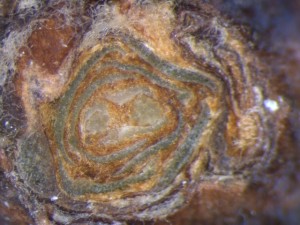Bud Dissection Can Guide Winter Grapevine Pruning Decisions

Cross section of Fiesta bud anatomy. In the center are two cluster primordia in the primary bud.
Bud dissection can help growers predict yield variation and adjust the number of spurs left when pruning.
Buds are dissected after harvest to count the number of cluster primordia under a microscope. This provides an estimate of the number of clusters for the following year, explains George Zhuang, University of California Cooperative Extension viticulture farm advisor for Fresno County.
How To Do It
To dissect buds, you’ll need razor blades, a dissecting microscope with a good light source, and a notebook or computer for documentation.
Buds are dissected perpendicularly starting at the top to reveal the compound bud’s interior, Zhuang explains. The cluster primordia will be next to the shoot apex and surrounded by leaf primordia and protective hair. Cluster primordia from primary buds and secondary buds should be counted separately on different node positions on the spur or cane. Double compound buds also should be dissected.
“By comparing the number of cluster primordia per node from this year with data from last year, growers can decide if the number of clusters will be more or less, and the number of nodes left during the pruning can be adjusted to make the bunches or vine more consistent for the coming year in order to have more consistent yield,” Zhuang says.
Buds can be dissected any time after veraison, but after harvest and before pruning is the best time frame, Zhuang adds. “Like any crop estimation method, sampling is very important to have accurate results,” he says. “Taking enough samples of spurs or canes randomly through the whole field to cover both high and low yielding areas is the key. Ideally, 100 spurs with two nodes per spur and 50 canes with 15 nodes per cane will be a good sample size for 50 acres of vineyard in the Fresno area.”
Things To Consider
Zhuang says that bud dissection can be less useful in cool climate areas that have a higher frequency of frost, freezing and hail damage. “All these damages can change the number of clusters per vine by killing the buds or shoots to make the bud dissection data less valuable,” he says.
He adds that when using bud dissection as a pruning tool, extra precautions should be made when yield variation is predicted.
“Growers need to generate the correlation of bud dissection data with bunches per node to see the accuracy of the prediction, and minimally three years’ data are needed to generate the correlation between number of cluster primordia, number of clusters, and eventually yield,” he says.









